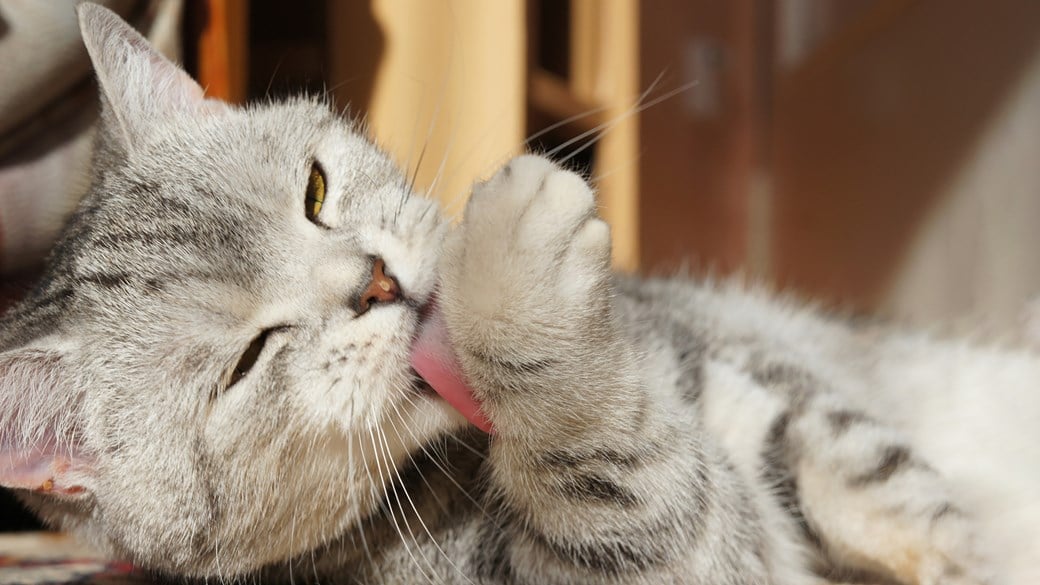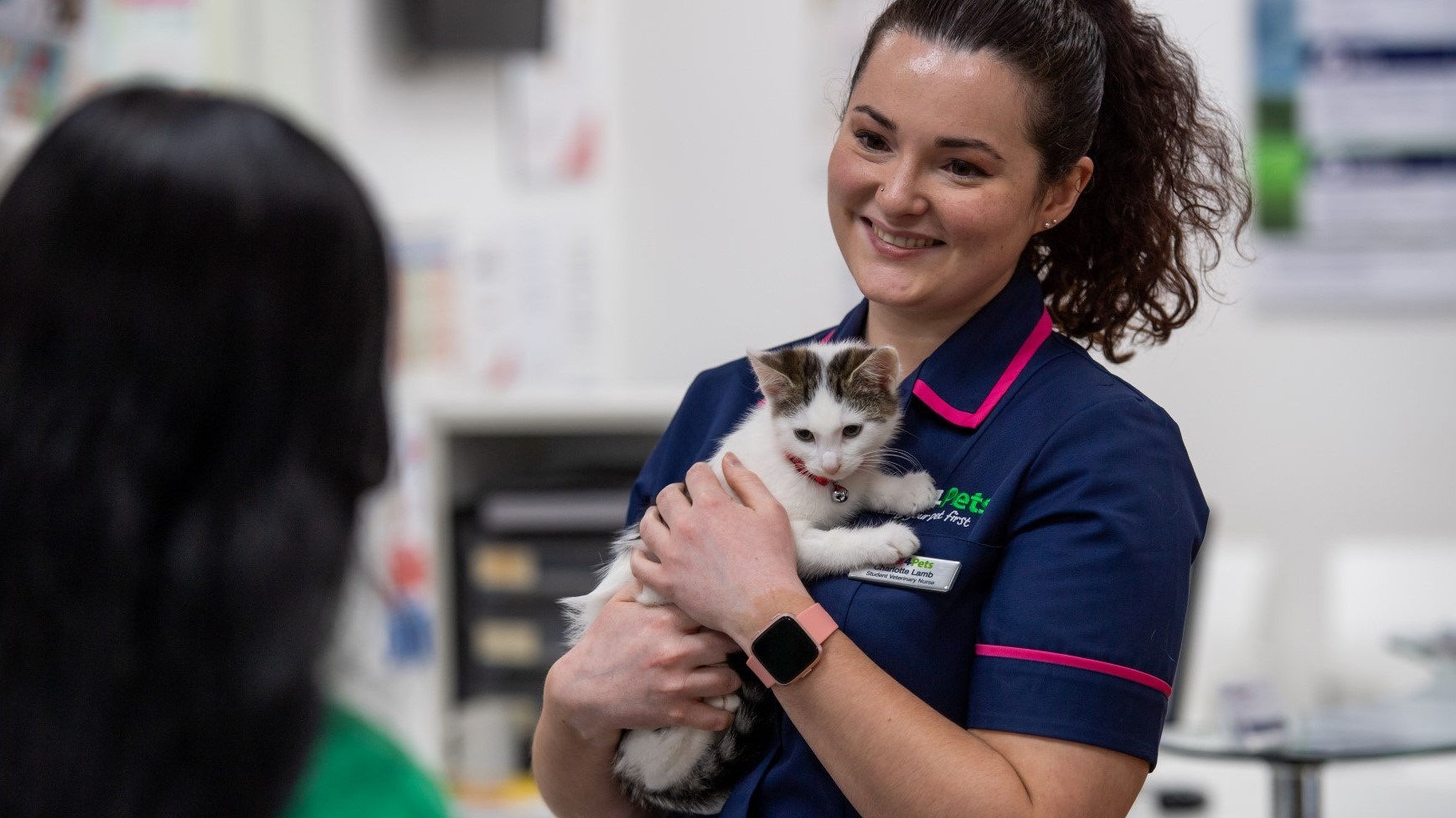
Grooming Cats
Read about the importance of grooming your cat
Cats are very good at grooming themselves and keeping their claws in tip-top condition. But did you know that there are additional health and welfare benefits to be had by teaching your cat to allow you to groom them, too?
A bonus to grooming is it gives you the opportunity to check your cat’s skin for any lumps, bumps or those pesky fleas and ticks!
Commonly asked questions
Longhaired cats should ideally be brushed at least once a day, whereas short haired will often be fine with once a week. If you start when they are young, they will quickly get used to the experience and not only is it good for their coats, it can be a wonderful bonding process for you and your cat.
If you’ve never groomed your cat before, it’s always important to start off slowly and let them get used to the process. One good way is to let them sniff the brushes before you use them. Many cats will rub their faces along the brushes when you do this, as they do gently move the brush along the top of their heads. If your cat seems happy with this, then gentle brush down their back and down their legs. If at any point your cat objects, stop for a moment and revert back to letting them sniff the brush. Little and often is the key to success to start with.
Some cats will try and grab at the brush, especially if you try to brush their tummy. This is usually a signal that they’ve had enough for the day, so it’s usually best to down tools at this stage.
It should never be a stressful experience for your cat to be groomed at home. If your cat reacts in a negative way, especially when you groom a specific area of them it could be worth having a check-up with your local vet as sometimes this can be a sign of arthritis or another underlying condition causing discomfort.
There’s lots of choice available when it comes to grooming brushes for cats. Some focus on removing the underlying “dead” fur, whilst others are for the simple smoothing of the upper layers of fur. Your choice will often depend on whether you have a long-haired or short-haired cat.
Some cats love being brushed with soft plastic type combs, it’s more of a massage for them but still has the benefit of helping to groom. If you have a particularly nervous cat this could be a good way to start, perhaps when they’re nicely settled on your lap.
There’s a really good guide produced by our friends at Pets at Home about how to choose the best brush for your cat. Click here to take a look at it.
Read more about grooming your cat
When you groom your cat, you can use your eyes, as well as your fingers, to check them over thoroughly. You’ll be able to spot parasites, such as fleas and ticks, and also wounds, before they become a problem. You can gently examine ears for any unusual smells or discharge.
As you work gently through your cat’s coat, you’ll be able to detect any clumps of hair that may be the beginning of a mat. Cats moult constantly, and mats can develop when hairs fall out and drop into the rest of the coat. If the loose hairs are not brushed out, and especially if the coat isn’t clean, they can build up and weave the living hairs together. Mats are uncomfortable because they pull on the skin, and they can interfere with movement. They also collect debris and dirt and, once mats begin, they can soon build up.
If you can remove loose hairs regularly, mats shouldn’t have a chance to develop and grooming need not become a big or uncomfortable event. Some breeds of cat with soft, long coats, develop mats very easily and will need to be checked and groomed regularly from a young age. Even short-coated cats can suffer from a build-up of loose hairs, matting their coat into uncomfortable clumps. When cats groom themselves, they swallow much of the loose hair. By brushing or combing out loose hairs, you might help to prevent your cat from getting hairballs.
Harvest mites can be a problem in some parts of the UK, especially in the South. These are much easier to find with your fingers, as the first sign of them is normally itchy or sticky scabs. If you do find small scabs on your cat, take a close look, using a magnifying glass if you need to, and see whether you can spot tiny, bright orange, powdery specks among the scabs. Favourite hiding places for harvest mites include between cats’ toes, under the chin and in the little pockets on the outside edge of cats’ ears. If you find scabs or crusting on your cat’s skin, or if you suspect a harvest mite infestation, get your cat checked out by your vet as, left untreated, harvest mites can make pets sore and uncomfortable.
Many cats do like to be groomed, once they’re used to it, but it has to be on their own terms! Keep sessions very short at the beginning, offer treats if your cat likes them, and allow your cat to choose whether or not to stay.
If you have a selection of grooming items, such as a soft bristle brush, a grooming mitten and a comb, you can try them out and find out which areas your cat prefers to have groomed, and with which item. Many cats like to have their face, head and neck combed or brushed gently, and they will often choose to rub their faces against the brushes.
It’s best to keep a separate grooming kit for individual cats unless they are very bonded, as they may not appreciate being groomed with brushes that smell of other cats. Most cats are really sensitive on their tummies and, while some like having that area brushed, watch your cat’s reaction if you try to groom under there, in case they don’t like it at first.
Signs your cat isn’t enjoying being groomed include: twitching their tail or rippling their skin; gulping or licking their lips; flicking or flattening their ears; suddenly staring fixedly at your hand, or joining in with a burst of grooming of their own. If they start to growl, it’s a clear sign they’re telling you that you haven’t noticed their other signals and must stop in order to avoid a scratch or bite.
Cats are often happy to have their backs groomed, all the way down to their tail base, and you might be surprised with just how much loose hair finds its way there! If you find tangled or matted hair, be careful not to pull the skin when you try to free up the hairs. If the hair is long, you can hold the base of the tangled hairs between your fingers while you try to tease out the knots. It’s safest not to use scissors to remove a knot – it is very easy to cut the skin by accident, as it forms a little tent under a knot. Your vet team or groomer can help you to remove a mat, using clippers, if necessary. Groomers sometimes offer ‘cats only’ days.
Mats that are serious enough to need professional attention often also require cats to be sedated or anaesthetised to help them cope with the experience. It’s much better to do everything you can to keep on top of your cat’s coat from the beginning, in order to avoid this. As a general rule, shorthaired cats benefit from being groomed about once a week unless they are moulting heavily, when you can step up the frequency. Longhaired cats need to be groomed at least once a day to keep their coats healthy and tangle-free.
Unless a cat has become covered in something unpleasant, they don’t need to be bathed and most do not tolerate it well at all!
Healthy cats can keep their own claws to a normal length and shape, by using things like scratching posts, tree trunks and fence posts, so you don’t need to trim them routinely. Cats use their claws for climbing, hunting and self-defence, so those with access to the outdoors need their claws to be sharp. If, for any reason, a cat isn’t able to do take care of their own claw sharpening, for instance, when they become older, you may need to help them.
If you have an indoor cat and you can hear their claws catching in carpets or clicking on hard floors, they might benefit from having just the tips trimmed. Claws that have overgrown and become misshapen can grow into the toe pads, causing pain and infection, so check your cat’s claws from time to time when you’re grooming them. To check a cat’s claw, place your finger and thumb on top of and underneath a toe and squeeze gently, to make the claw extend outwards. If you suspect your cat’s claw has grown into their pad, contact your vet.
Grooming can be enjoyable and relaxing for both you and your cat if you take time to let them get used to it. Pay attention to and respect their wishes, always finish while they are still enjoying it, and you’ll both benefit from the quality time spent together.
Health Plans to keep your cat healthy
At Vets4Pets we offer a range of Health Plans that make essential routine treatments more affordable. You'll save money on things like annual vaccinations, flea and worm treatment and routine health check-ups.

Cat Advice
Read more of our expert cat advice to keep your cat happy and healthy.
